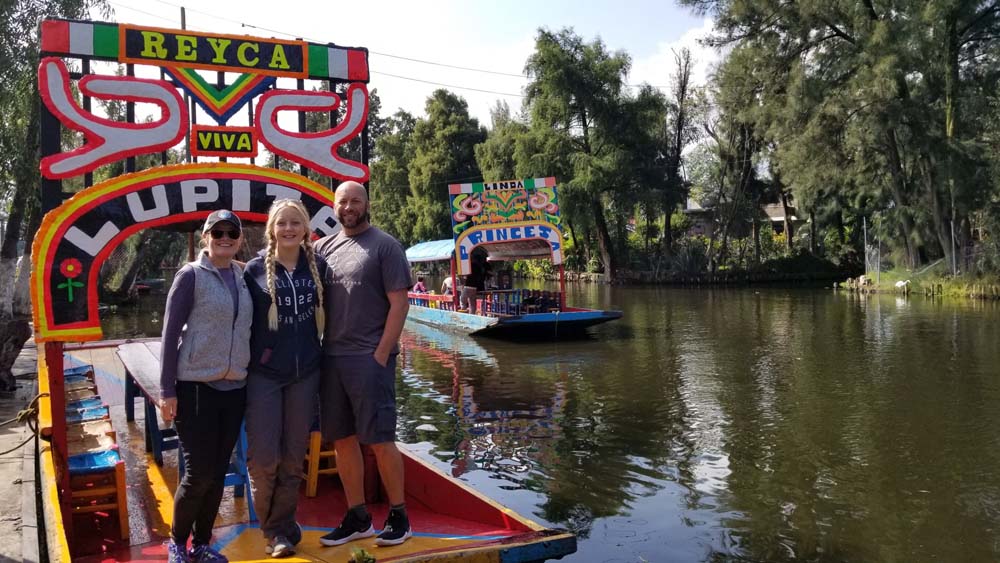 Adventuriety
Adventuriety
Day three in Mexico City and our second tour. I wanted to see a little bit more of Mexico City and signing us up for another tour was an easy way to do it. Besides, Frida Kahlo’s house was on the tour and I was excited to visit it.
Our first scheduled stop was Xochimilco, the last remnants of the Aztec’s intricate canal and farming system of chinampas, but first, we drove through a few lanes of small nursery shops. This is the place where local landscapers shop for all of the ingredients of a beautiful yard. Everything is inexpensive and food and coffee vendors walk the lanes selling breakfast amongst the flowers.
Because it was early and a weekday, there were not many of the bright gondola-like boats moving around in the canals.
 On the weekends, the canals are full of boats and people eating, drinking and listening to their own music or the mariachi bands that move from boat to boat. You pay by the hour for a boat that holds about 20 people and you can take all the food, drink, and music you want with you. One can also purchase snacks and drinks from vendors’ boats.
On the weekends, the canals are full of boats and people eating, drinking and listening to their own music or the mariachi bands that move from boat to boat. You pay by the hour for a boat that holds about 20 people and you can take all the food, drink, and music you want with you. One can also purchase snacks and drinks from vendors’ boats.
We couldn’t decide if this boat of partiers started early or it was a continuation from the night before.
The area is interesting. People still live along the canals in what seems to be grittier neighborhoods.
And they use these waterways to get around, not just to relax on the weekend.
Along with the private homes along the canals, there are also nurseries.
We docked at one of the nurseries and wandered through it.
Notice the living Lady of Guadalupe behind Ashley.
Our guide told us that the water in the canals is clean enough to swim in, but not to drink.
You can see the egrets fishing along the opposite shore and we also saw ducks swimming along beside the boats.
Our unexpected “bonus stop” on this tour came with us onto the boat. A man with a giant black briefcase boarded the boat at some point and sat quietly for most of the trip. I thought he was just another passenger, maybe using the boat for transportation to another stop. But no, he was our local craftsman wanting to sell us some of his jewelry, all made painstakingly by hand (according to him). Yes, we purchased a piece…it’s so hard to know what to do.
The boats are propelled and steered only by human power. Ashley took a turn at steering the boat into the dock and did a good job.
The canals of Xochimilco are eerily beautiful, a quiet space in the jumble of Mexico City, tranquil enough on this morning that you could almost imagine the Aztecs moving through their brilliant infrastructure and cultivating their crops, planted on man-made garden boxes in the canals.
Then, there is the contrast of the modern, yet dilapidated homes, along the shores and the signs strung up in trees advertising concerts and films. Xochimilco is truly representative of the jumble of history and culture that is Mexico City.
After the boat ride, I asked our guide to take us back to the outdoor nursery. We had all thought it was beautiful and I wanted some time to really enjoy it. Besides, it’s only fair that I get to plan some surprise detours as well!
There was stall after stall of plants and flowers, each one more beautiful than the next.
Each stall had a human tucked inconspicuously behind the foliage.
There were succulents and ferns…
Rocks of all sizes and herbs…
Walking through the little garden shops was my favorite part of the day.
Our next stop was the National Autonomous University of Mexico, a prestigious and free public college. First founded in 1551 by Antonio de Mendoza, the first viceroy of New Spain, the university was relocated and a sparkling new campus opened in 1954. We visited “Ciudad Universitaria” (University City), UNAM’s main campus, located within the Coyoacán borough in the southern part of Mexico City.
Estadio Olímpico Universitario
The main campus is huge; 2,500 acres, 2000 buildings, and over 350,000 students, it even has a nature reserve. Above is the university’s Olympic stadium. The mosaic on the stadium that you can kind of make out is a Diego Rivera mural called “The University, the Mexican Family, Peace and Youth Sports.” Little did I realize it, but my obsession with Diego Rivera was awakening. Diego planned that this mural would wrap around the stadium’s entire facade and tell the history of sports in Mexico from the pre-Hispanic era to the present, but it was never finished.
Biblioteca Central
This is the Central Library at UNAM. The ten-story building is completely decorated with the mural “Historical Representation of Culture.” It is a mosaic designed by Juan O’Gorman, a Mexican architect and muralist, known for his mosaics. In July 2007, the Central Library, along with the Central Campus of the University City, became a UNESCO World Heritage Site.
Museo Diego Rivera Anahuacalli
We moved on to Diego Rivera’s Anahuacalli Museum. Diego Rivera was fascinated by ancient Mexican history and collected artifacts, around 50,000 pre-Hispanic pieces from almost every indigenous civilization in Mexico’s history. Rivera wanted a place to exhibit them and so he designed and built a striking building for his collection. The museum is interesting in itself. It is built from black volcanic stone and is shaped loosely like a pyramid. It is not that big, and few of the artifacts are labeled or dated. I really liked the second floor, an exhibition room dedicated to the life and works of Rivera, and the observation deck, where Ashley and I enjoyed the view (above).
Museo de Frida Kahlo La Casa Azul
We continued our tour of the Coyoacán area and the “Mexican artists” theme with the Frida Kahlo Museum, also called The Blue House. Frida Kahlo was married to Diego Rivera. Diego Rivera was a whole lot of things including a talented artist and a revolutionary when he met Frida Kahlo. Their story is complicated and definitely deserves a dedicated blog (My New Friends, Frida and Diego), but I will say that individually and together, their cumulative saga is fascinating to me and I cannot stop thinking about them. This is the house that Frida grew up in, shared with Diego, and died in. She was not as famous as Diego until Salma Hayek recreated her life in the biopic Frida in 2002.
Now, as our guide pointed out at both places, The Blue House is constantly packed with tourists (buy your time-stamped entrance ticket before you go!) and the Anahuacalli Museum is considered busy with a handful of people.
Fuente de los Coyotes in Jardin Centenario
Welcome to the center of Coyoacán; hip, happening, notoriously prestigious and one of the oldest neighborhoods in Mexico City. Coyoacán or “place of coyotes,” in the Aztec language Nahuatl, was a pre-Hispanic community on the southern shore of Lake Texcoco (remember my dream and the giant lake? Sailboats and History Mexico City) dominated by the Tepanec people. Ironically, the village that the Aztecs named after a large population of wild coyotes living in the area welcomed human coyotes, Hernán Cortés and the Spanish with open arms. The Tepanec people didn’t appreciate how the Aztecs treated them and so they fought alongside the Spanish while allowing them to use Coyoacán as their headquarters. The Spanish made Coyoacán their temporary first capital of New Spain between 1521 and 1523 while they “retrofitted” Tenochtitlan.
Do not miss the churros in Coyoacán especially with Nutella…all that sugar helps you to focus on the history!
This is just a part of Plaza Hidalgo with a view of Parish of San Juan Bautista church, built between 1520 and 1552. This plaza is located just across the street from Jardin Centenario (the park with the coyote fountain). Centro Coyoacán seems to possess a sort of magical allure from those first coyotes to the Spanish (this is where Cortés built his permanent home after all) to European settlers, artists, politicians, revolutionaries, and today, families spending a Saturday or Sunday away from the noise and pollution of Mexico City.
We finished our tour with a walk through this mostly “handicraft” market (of obviously mass produced stuff) in Centro Coyoacán and then we walked a few blocks to a local market.
The local market was more about food…you could find anything here from lunch to bulk spices to fresh produce to candy.
I couldn’t resist picking up a few avocados for 30 pesos…a little more than a dollar.
The markets are like the mosaic art in Mexico, it’s difficult to understand how all of the pieces fit together to make such an intricate picture. And furthermore, that humans imagine it.
Scott and Ashley have become very fond of Dulce de leche, a very sweet and sticky caramel type candy. We found some here and made our way very slowly back to our apartment through the lethargic afternoon traffic.
Comments
Comments are closed.










































“The markets are like the mosaic art in Mexico, it’s difficult to understand how all of the pieces fit together to make such an intricate picture.” My favorite line!
Awww! Thank you!
Hi, very nice website, cheers!
——————————————————
Need cheap and reliable hosting? Our shared plans start at $10 for an year and VPS plans for $6/Mo.
——————————————————
Check here: https://www.good-webhosting.com/